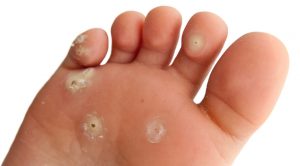Heel Fissures (Cracked Heel) occur when the skin on the bottom, outer or inner edge of the heel become thick, hard, dry and flaky. These hard skin eventually split as it loses its elasticity. The split(s) or fissure(s) can be painful and can bleed and become a portal of entry for bacteria and lead to possible infection in people with compromised immune system (eg. patients with diabetes or seniors).
What are the causes for Heel Fissures (Cracked Heel)?
- Living in a dry environment (winter in Canada)
- Obesity (more pressure to heel)
- Consistently walking barefoot or wearing sandals (increase exposure to extreme environment)
- Inactive sweat/oil glands (diabetes or congenital causes)
Why should you be concerned about heel fissure?
If left untreated, heel fissure can become more dangerous as the split tends to become deeper. This can results in deeper skin cracks leading to pain and infection.
Treatment
- Regular moisturizing (choose cream with Urea or one that is recommend by your foot specialist) for 1-2 times a day
- Regular thinning of the callus (pumice stone daily gentle scrub)
- Avoid barefoot or wearing open-backed shoes, sandals
- Wear shoes with strong shock absorption
- If the fissures still does not resolve, consult your foot specialist (chiropodist/podiatrist)

